
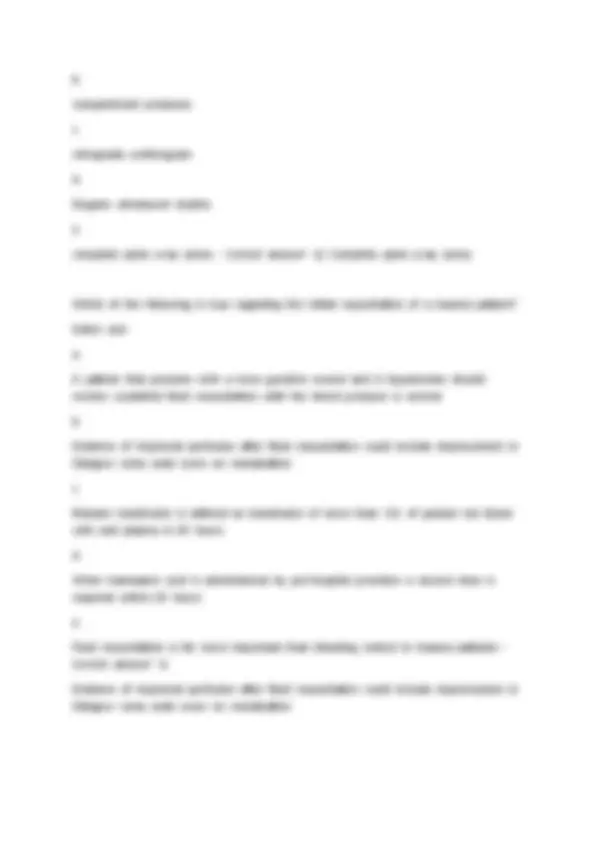
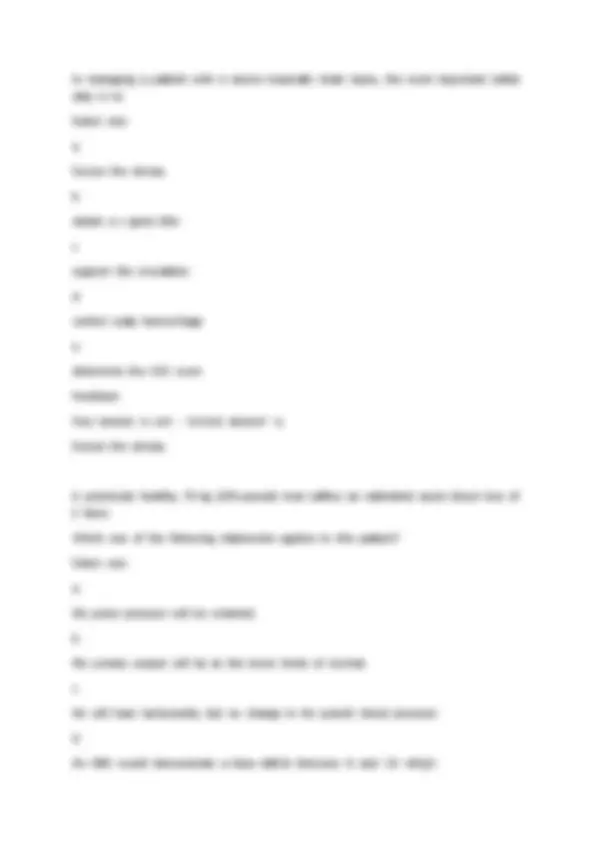
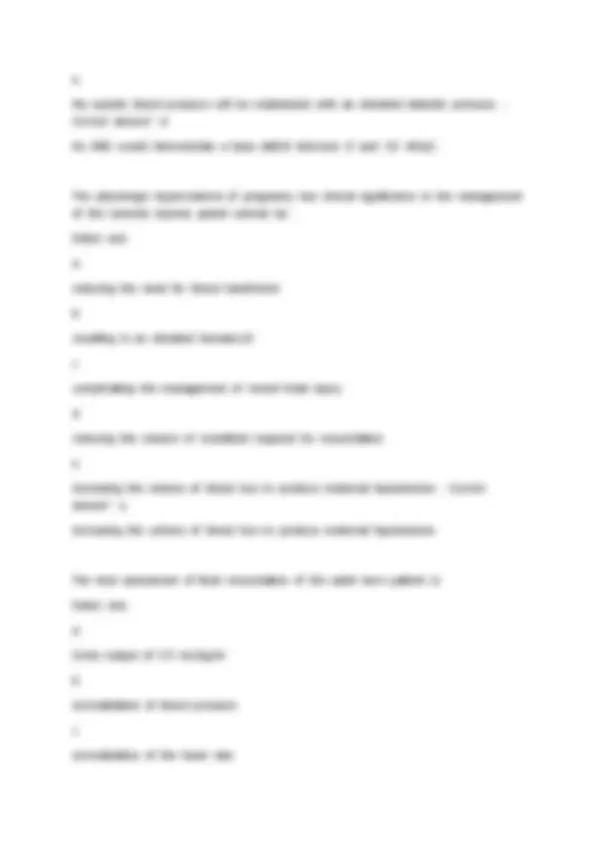
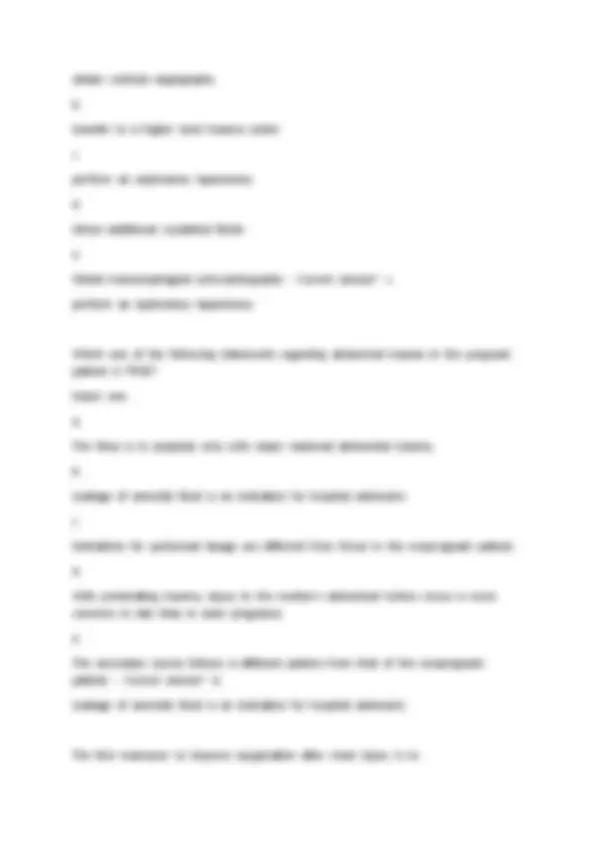
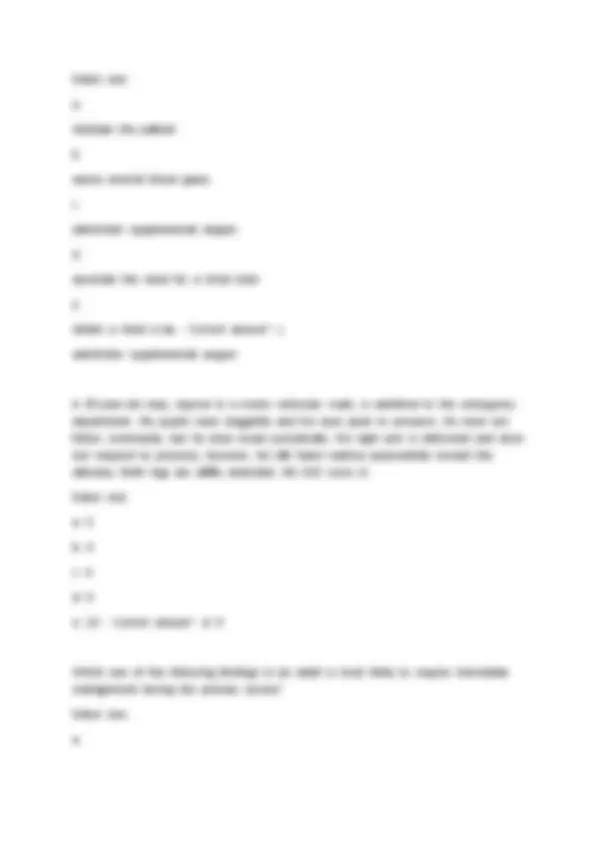
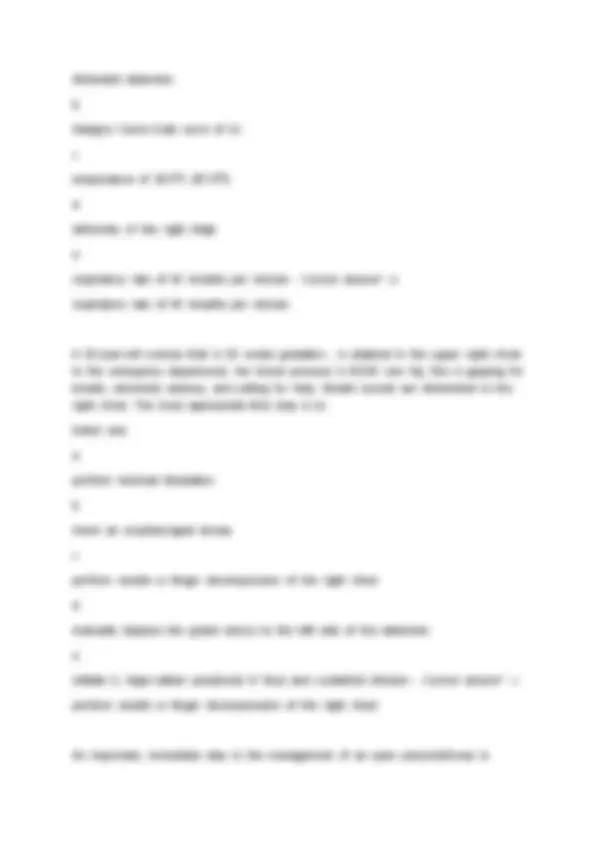
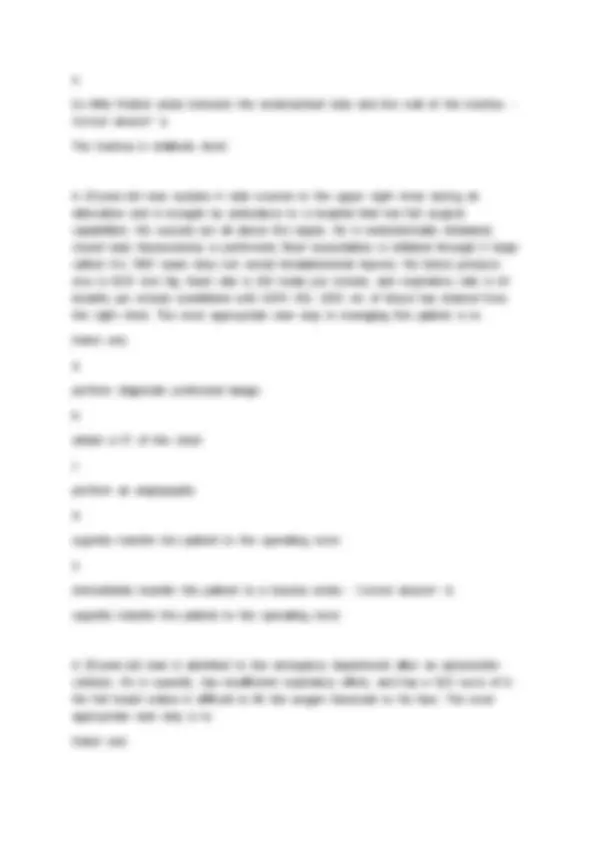
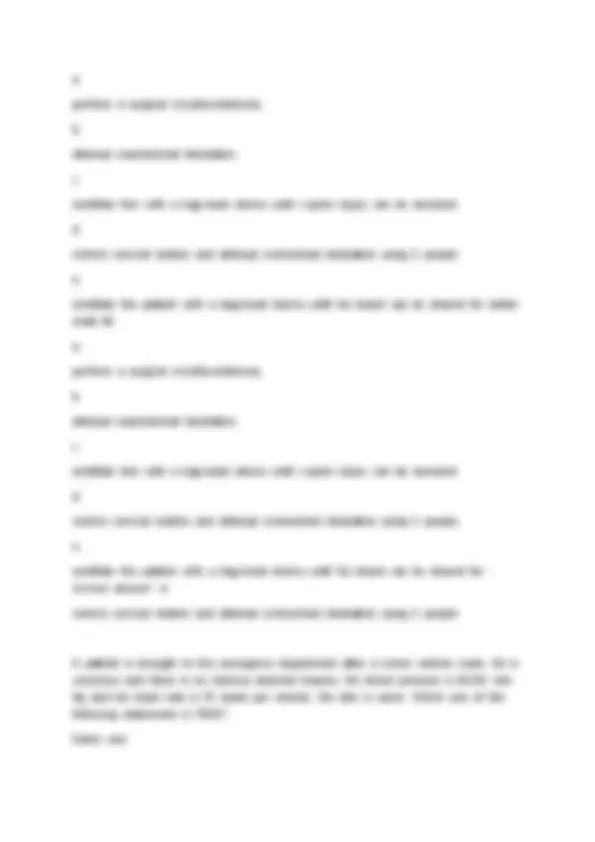
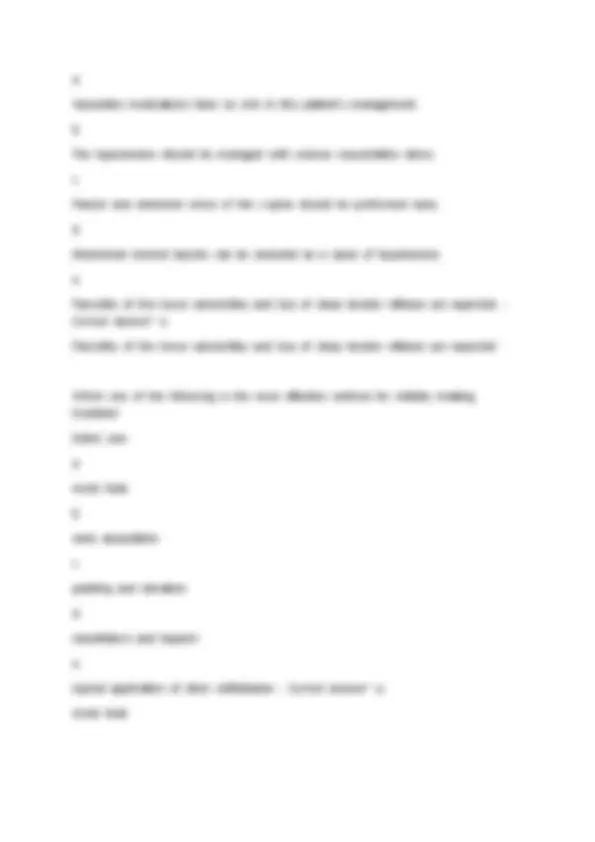
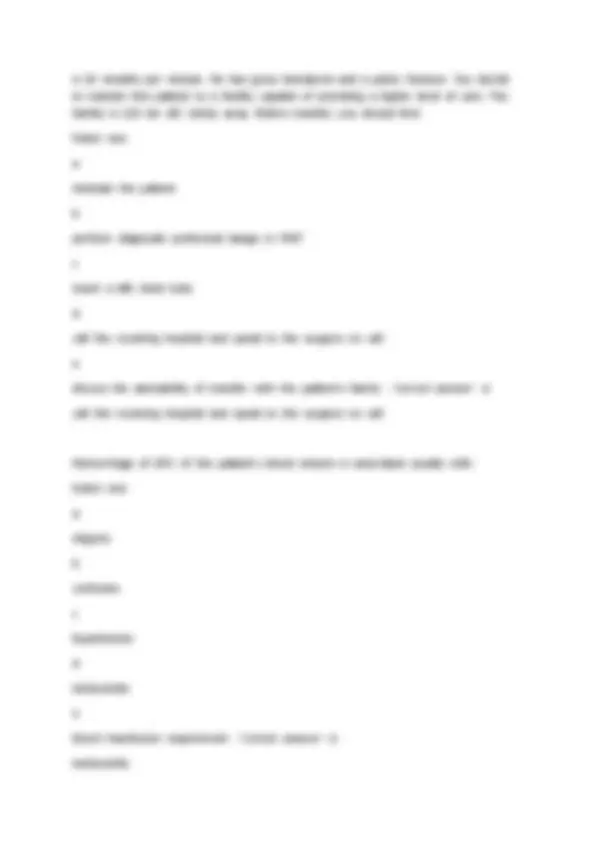
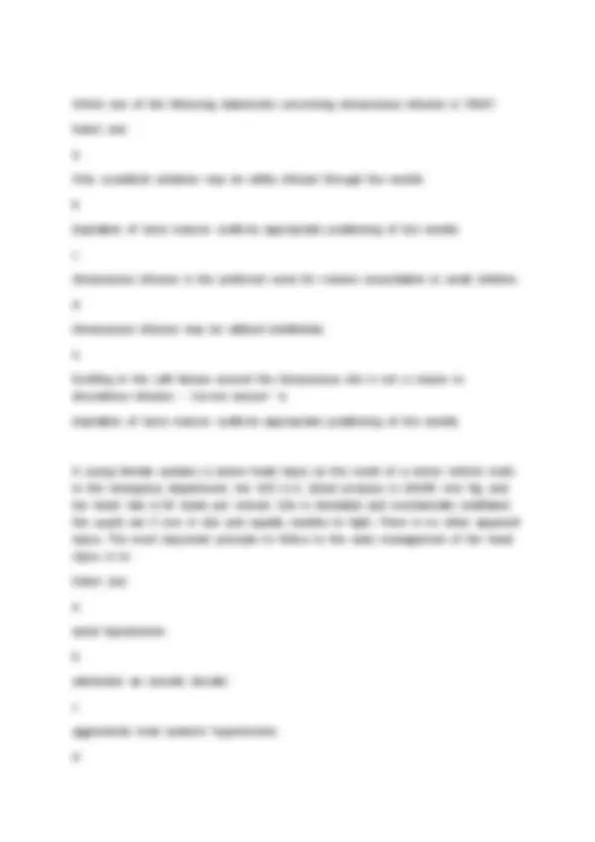
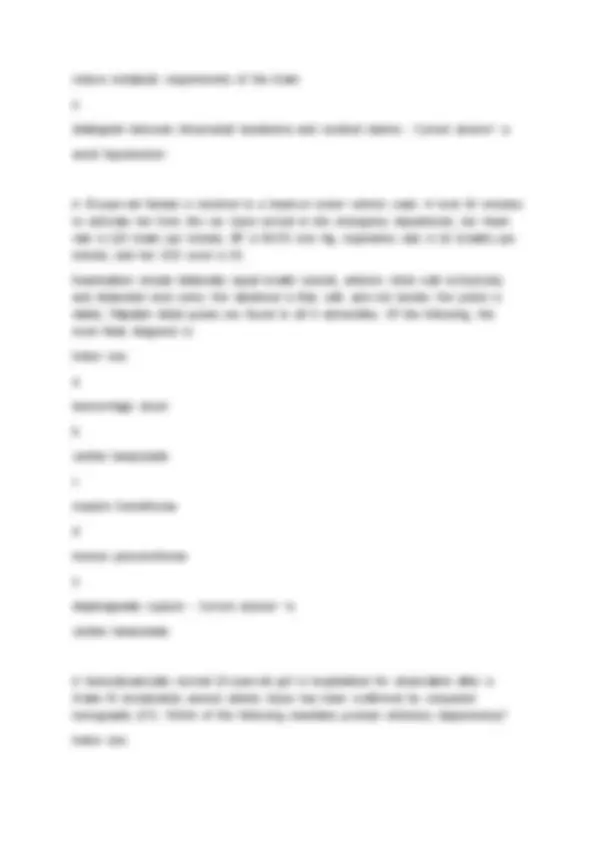
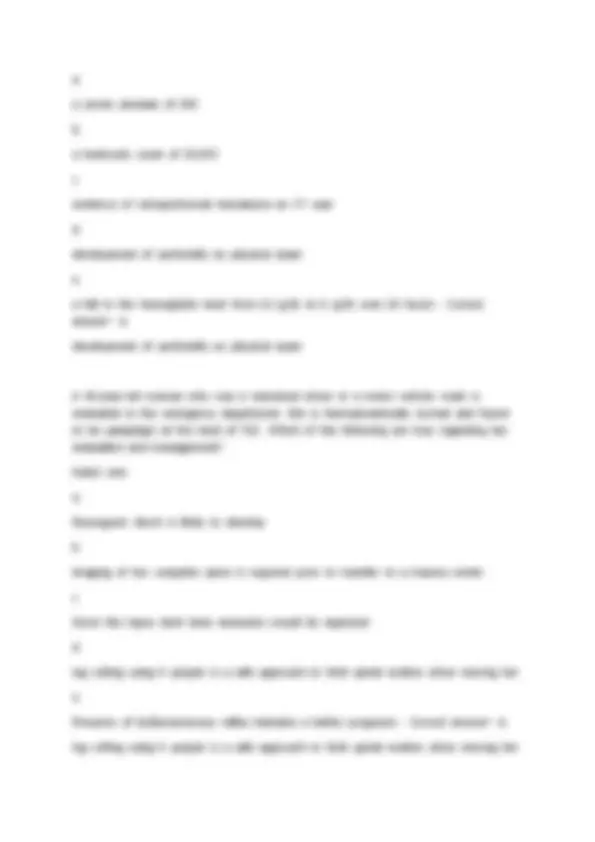


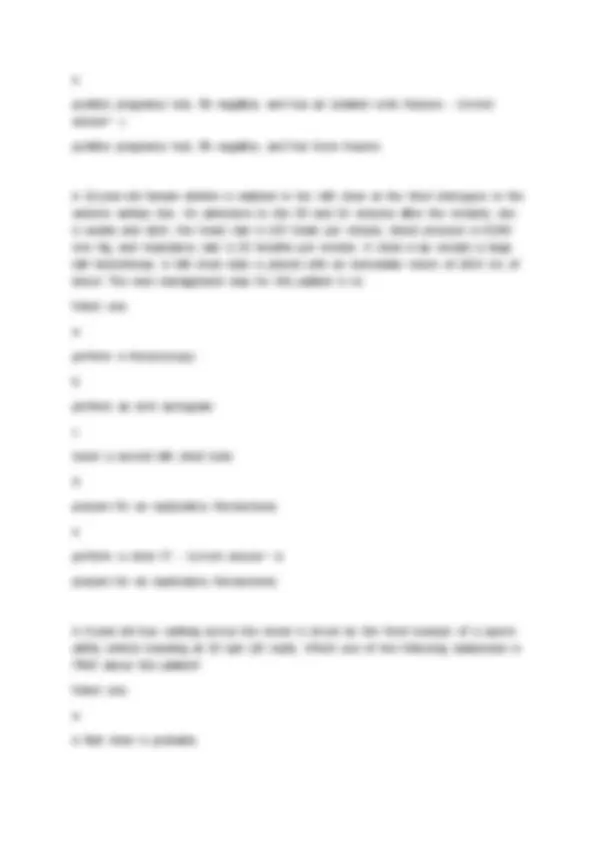



Study with the several resources on Docsity

Earn points by helping other students or get them with a premium plan


Prepare for your exams
Study with the several resources on Docsity

Earn points to download
Earn points by helping other students or get them with a premium plan
Community
Ask the community for help and clear up your study doubts
Discover the best universities in your country according to Docsity users
Free resources
Download our free guides on studying techniques, anxiety management strategies, and thesis advice from Docsity tutors
ATLS TEST 1 QUESTIONS AND CORRECT ANSWERS.pdf
Typology: Exams
1 / 25

This page cannot be seen from the preview
Don't miss anything!


















A 22 - year-old man is hypotensive and tachycardic after a shotgun wound to the left shoulder. His blood pressure is initially 80/40 mm Hg. After initial fluid resuscitation his blood pressure increases to 122/84 mm Hg. His heart rate is now 100 beats per minute and his respiratory rate is 28 breaths per minute. A tube thoracostomy is performed for decreased left chest breath sounds with the return of a small amount of blood and no air leak. After chest tube insertion, the most appropriate next step is: Select one: a. reexamine the chest b. perform an aortogram c. obtain a CT scan of the chest d. obtain arterial blood gas analyses e. perform transesophageal echocardiography - Correct answer~ A) Reexamine the chest A construction worker falls two stories from a building and sustains bilateral calcaneal fractures. In the emergency department, he is alert, vital signs are normal, and he is complaining of severe pain in both heels and his lower back. Lower extremity pulses are strong and there is no other deformity. The suspected diagnosis is most likely to be confirmed by: Select one: a. angiography
In managing a patient with a severe traumatic brain injury, the most important initial step is to: Select one: a. Secure the airway b. obtain a c-spine film c. support the circulation d. control scalp hemorrhage e. determine the GCS score Feedback Your answer is corr - Correct answer~ a. Secure the airway A previously healthy, 70 - kg (154-pound) man suffers an estimated acute blood loss of 2 liters. Which one of the following statements applies to this patient? Select one: a. His pulse pressure will be widened. b. His urinary output will be at the lower limits of normal. c. He will have tachycardia, but no change in his systolic blood pressure. d. An ABG would demonstrate a base deficit between - 6 and - 10 mEq/L
e. His systolic blood pressure will be maintained with an elevated diastolic pressure. - Correct answer~ d. An ABG would demonstrate a base deficit between - 6 and - 10 mEq/L The physiologic hypervolemia of pregnancy has clinical significance in the management of the severely injured, gravid woman by: Select one: a. reducing the need for blood transfusion b. resulting in an elevated hematocrit c. complicating the management of closed head injury d. reducing the volume of crystalloid required for resuscitation e. increasing the volume of blood loss to produce maternal hypotension - Correct answer~ e. increasing the volume of blood loss to produce maternal hypotension The best assessment of fluid resuscitation of the adult burn patient is: Select one: a. Urine output of 0.5 mL/kg/hr b. normalization of blood pressure c. normalization of the heart rate
c. packing the wound with gauze d. direct pressure on the femoral artery at the groin e. debridement of devitalized tissue - Correct answer~ b. direct pressure on the wound For the patient with severe traumatic brain injury, profound hypocarbia should be avoided to prevent: Select one: a. respiratory acidosis b. metabolic acidosis c. cerebral vasoconstriction with diminished perfusion d. neurogenic pulmonary edema e. shift of the oxyhemoglobin dissociation curve - Correct answer~ c. cerebral vasoconstriction with diminished perfusion After being involved in a motor vehicle crash, a 25 - year-old man is brought to a hospital that has surgery capabilities available.. Computed tomography of the chest and abdomen shows an aortic injury and splenic laceration with free abdominal fluid. His blood pressure falls to 70 mm Hg after CT. The next step is: Select one: a.
obtain contrast angiography b. transfer to a higher level trauma center c. perform an exploratory laparotomy d. infuse additional crystalloid fluids e. Obtain transesophageal echocardiography - Correct answer~ c. perform an exploratory laparotomy Which one of the following statements regarding abdominal trauma in the pregnant patient is TRUE? Select one: a. The fetus is in jeopardy only with major maternal abdominal trauma. b. Leakage of amniotic fluid is an indication for hospital admission. c. Indications for peritoneal lavage are different from those in the nonpregnant patient. d. With penetrating trauma, injury to the mother's abdominal hollow viscus is more common in late than in early pregnancy. e. The secondary survey follows a different pattern from that of the nonpregnant patient. - Correct answer~ b. Leakage of amniotic fluid is an indication for hospital admission. The first maneuver to improve oxygenation after chest injury is to:
distended abdomen b. Glasgow Coma Scale score of 11 c. temperature of 36.5°C (97.8°F) d. deformity of the right thigh e. respiratory rate of 40 breaths per minute - Correct answer~ e. respiratory rate of 40 breaths per minute A 20 - year-old woman that is 32 weeks gestation , is stabbed in the upper right chest. In the emergency department, her blood pressure is 80/60 mm Hg. She is gasping for breath, extremely anxious, and yelling for help. Breath sounds are diminished in the right chest. The most appropriate first step is to: Select one: a. perform tracheal intubation b. insert an oropharyngeal airway c. perform needle or finger decompression of the right chest d. manually displace the gravid uterus to the left side of the abdomen e. initiate 2, large-caliber peripheral IV lines and crystalloid infusion - Correct answer~ c. perform needle or finger decompression of the right chest An important, immediate step in the management of an open pneumothorax is:
Select one: a. endotracheal intubation b. operation to close the wound c. placing a chest tube through the chest wound d. placement of an occlusive dressing over the wound secured on three sides e. initiation of 2, large-caliber IVs and infusing crystalloid solution - Correct answer~ d. placement of an occlusive dressing over the wound secured on three sides Which of the following is a contraindication for tetanus toxoid administration? Select one: a. history of neurological reaction or severe hypersensitivity to the product b. Local side effects c. muscular spasms d. pregnancy e. all of the above - Correct answer~ a. history of neurological reaction or severe hypersensitivity to the product
e. So little friction exists between the endotracheal tube and the wall of the trachea. - Correct answer~ a. The trachea is relatively short. A 23 - year-old man sustains 4 stab wounds to the upper right chest during an altercation and is brought by ambulance to a hospital that has full surgical capabilities. His wounds are all above the nipple. He is endotracheally intubated, closed tube thoracostomy is performed, fluid resuscitation is initiated through 2 large- caliber IVs. FAST exam does not reveal intraabdominal injuries. His blood pressure now is 60/0 mm Hg, heart rate is 160 beats per minute, and respiratory rate is 14 breaths per minute (ventilated with 100% O2). 1500 mL of blood has drained from the right chest. The most appropriate next step in managing this patient is to Select one: a. perform diagnostic peritoneal lavage b. obtain a CT of the chest c. perform an angiography d. urgently transfer the patient to the operating room e. immediately transfer the patient to a trauma center - Correct answer~ d. urgently transfer the patient to the operating room A 39 - year-old man is admitted to the emergency department after an automobile collision. He is cyanotic, has insufficient respiratory effort, and has a GCS score of 6. His full beard makes it difficult to fit the oxygen facemask to his face. The most appropriate next step is to Select one:
a. perform a surgical cricothyroidotomy b. attempt nasotracheal intubation c. ventilate him with a bag-mask device until c-spine injury can be excluded d. restrict cervical motion and attempt orotracheal intubation using 2 people e. ventilate the patient with a bag-mask device until his beard can be shaved for better mask fit a. perform a surgical cricothyroidotomy b. attempt nasotracheal intubation c. ventilate him with a bag-mask device until c-spine injury can be excluded d. restrict cervical motion and attempt orotracheal intubation using 2 people e. ventilate the patient with a bag-mask device until his beard can be shaved for - Correct answer~ d. restrict cervical motion and attempt orotracheal intubation using 2 people A patient is brought to the emergency department after a motor vehicle crash. He is conscious and there is no obvious external trauma. His blood pressure is 60/40 mm Hg and his heart rate is 70 beats per minute. His skin is warm. Which one of the following statements is TRUE? Select one:
A 32 - year-old man's right leg is trapped beneath his overturned car for nearly 2 hours before he is extricated. On arrival to the emergency department, his right lower extremity is cool, mottled, insensate, and motionless. Despite normal vital signs, a pulse cannot be palpated below the right femoral artery and the muscles of the lower extremity are firm and hard. During the management of this patient, which of the following is most likely to improve the chances for limb salvage? Select one: a. applying skeletal traction b. administering anticoagulant drugs c. administering thrombolytic therapy d. surgical consultation for right lower extremity fasciotomy e. transferring the patient to the trauma center 120 km away - Correct answer~ d. surgical consultation for right lower extremity fasciotomy A patient arrives in the emergency department after being beaten about the head and face with a wooden club. He is comatose and has a palpable depressed skull fracture. His face is swollen and ecchymotic. He has gurgling respirations and vomitus on his face and clothing. The most appropriate step after providing supplemental oxygen and elevating his jaw is to: Select one: a. request a CT scan b. insert a gastric tube c. suction the oropharynx
d. obtain a lateral cervical spine x-ray e. ventilate the patient with a bag-mask - Correct answer~ c. suction the oropharynx A 22 - year-old man sustains a gunshot wound to the left chest and is transported to a small community hospital; no surgical capabilities are available. In the emergency department, a chest tube is inserted and 700 mL of blood is evacuated. The trauma center accepts the patient in transfer. Just before the patient is placed in the ambulance for transfer, his blood pressure decreases to 80/68 mm Hg and his heart rate increases to 136 beats per minute. The next step should be to: Select one: a. clamp the chest tube b. cancel the patient's transfer c. perform an emergency department thoracotomy d. repeat the primary survey and proceed with transfer e. delay the transfer until the referring doctor can contact a thoracic surgeon - Correct answer~ d. repeat the primary survey and proceed with transfer A 64 - year-old man involved in a high-speed car crash, is resuscitated initially in a small hospital without surgical capabilities. He has a closed head injury with a GCS score of 13. He has a widened mediastinum on chest x-ray with fractures of left ribs 2 through 4, but no pneumothorax. After initiating fluid resuscitation, his blood pressure is 110/74 mm Hg, heart rate is 100 beats per minute, and respiratory rate
Which one of the following statements concerning intraosseous infusion is TRUE? Select one: a. Only crystalloid solutions may be safely infused through the needle. b. Aspiration of bone marrow confirms appropriate positioning of the needle. c. Intraosseous infusion is the preferred route for volume resuscitation in small children. d. Intraosseous infusion may be utilized indefinitely. e. Swelling in the soft tissues around the intraosseous site is not a reason to discontinue infusion. - Correct answer~ b. Aspiration of bone marrow confirms appropriate positioning of the needle. A young female sustains a severe head injury as the result of a motor vehicle crash. In the emergency department, her GCS is 6, blood pressure is 140/90 mm Hg, and her heart rate is 80 beats per minute. She is intubated and mechanically ventilated. Her pupils are 3 mm in size and equally reactive to light. There is no other apparent injury. The most important principle to follow in the early management of her head injury is to: Select one: a. avoid hypotension b. administer an osmotic diuretic c. aggressively treat systemic hypertension d.
reduce metabolic requirements of the brain e. distinguish between intracranial hematoma and cerebral edema - Correct answer~ a. avoid hypotension A 33 - year-old female is involved in a head-on motor vehicle crash. It took 30 minutes to extricate her from the car. Upon arrival in the emergency department, her heart rate is 120 beats per minute, BP is 90/70 mm Hg, respiratory rate is 16 breaths per minute, and her GCS score is 15. Examination reveals bilaterally equal breath sounds, anterior chest wall ecchymosis, and distended neck veins. Her abdomen is flat, soft, and not tender. Her pelvis is stable. Palpable distal pulses are found in all 4 extremities. Of the following, the most likely diagnosis is: Select one: a. hemorrhagic shock b. cardiac tamponade c. massive hemothorax d. tension pneumothorax e. diaphragmatic rupture - Correct answer~ b. cardiac tamponade A hemodynamically normal 10 - year-old girl is hospitalized for observation after a Grade III (moderately severe) splenic injury has been confirmed by computed tomography (CT). Which of the following mandates prompt celiotomy (laparotomy)? Select one: